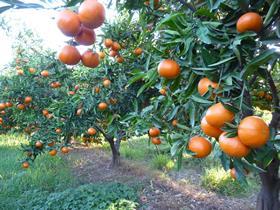
Oranges may still dominate the global citrus market in production, with global forecasts of 45.8 million tonnes for 2015-16, but in UK sales terms it is easy peelers that continue to reign supreme.
The easy peeler market grew by 3.4 per cent in the 52 weeks to 22 May 2016, according to Kantar data, cementing the product’s position as the top-selling citrus line. Oranges, by contrast, continue their gradual sales decline, with value sales of less than half the value of easy peelers in the past year.
“The challenge for the orange category is in relation to convenience, portability and out-of-home opportunities,” says Jo Mumford of Chingford Fruit. “Each element has contributed to the demand for smaller easy peelers.”
Shoppers are looking for an “easier to peel, less messy option”, adds Mumford – and this has limited orange sales, with suppliers finding it difficult to push the product ahead of clementines, mandarins and satsumas.
To meet this changing demand, MMG Citrus, a 50:50 joint venture between Fresca and Spanish citrus supplier Martinavarro, has had to adapt its procurement strategy. “Our easy peeler sales keep going from strength to strength,” says account technical manager Stuart Ansell. “There’s a definite upward trend in how we plan and procure easy peelers because we keep getting repeat sales.” In retailers, both trip volume and purchasing frequency are on the up, and promotional deals are helping to drive sales.
Nadorcott, a variety discovered in Morocco in 1982, now dominates MMG Citrus’ easy peeler range, and it has a become a “bit of a winner for supermarkets”, according to Ansell, being particularly popular on account of its sweet flavour and consistent quality.
The variety, which is at its best between February and April in the northern hemisphere and from August to October south of the equator, “ticks all the boxes” for consumers, according to MMG Citrus. “It looks good, it tastes good, it lasts on the shelf and in the fruit bowl, and the fruit from Morocco, Spain and South Africa is predominantly seedless.” Most importantly, it has a good sugar-to-acid balance, with Brix levels in excess of 11 degrees.
New varieties coming onto the market from Poupart’s citrus division Citrus First include late-season satsumas Aoshima and Imamura, and clementine variety Azem. The Moroccan variety has already proven popular with consumers, according to commercial manager Mark Bonifas, offering “outstanding eating quality with well-balanced acidity and sugars.”
Meanwhile, citrus importer AMT Fruit continues to supply Spanish-grown Octubrina, a variety launched exclusively at Tesco two years ago. Volumes for the variety are set to increase by 50 per cent on last year to around 75-80t.
“Early clementine varieties like Marisol and Arrufina are challenging when it comes to quality and yield,” says account director Matt Warren. “So the fact that Octubrina performs so well on both these fronts means it could be a real game changer for growers and consumers.”
When it comes to oranges, AMT Fruit has been trying to halt the slide in sales by investing in late navel types, which tend to have a better flavour than Valencia varieties. Varieties such as Fukumoto and M7 are being produced in greater volumes and the northern hemisphere season is being extended to May with the planting of new navel varieties, such as Cambria, Chislett, Powell and Barnfield.
Mumford, meanwhile, believes that highlighting varieties with easier to peel skins or sweeter, developed flavour attributes may prove key to boosting orange sales.
Growing conditions in the southern hemisphere have been problematic in 2016, affecting citrus across the board. A frost in Chile in September, combined with unusually dry weather in South Africa between April and June, has reduced yields and limited the size of fruit on British supermarket shelves.
AMT Fruit reports a “very difficult end to the South African season” due to a significant reduction in the Valencia orange crop, while Citrus First has experienced shortages of Midnight and Delta oranges from the country due to warm temperatures towards the end of the season. Dry weather in Spain also looks likely to reduce easy peeler fruit size up until Christmas.
In lemons, meanwhile, frosts and floods in Argentina and Citrus Black Spot issues in South Africa have limited supply, says Ansell, while high demand across the world means availability is a major challenge. This has not affected UK sales, however, which are enjoying year-on-year sales growth of nearly 20 per cent.
According to James Miller, commercial manager at Capespan International, food and drink trends are playing a major role in this strong sales performance, with a rise in scratch cooking and cocktails featuring lemons as a base. Britain’s gin boom, which has coincided with this sales growth in the past three years, has also been a major factor.



